Huffer Leaves a Void in UMD Puck History
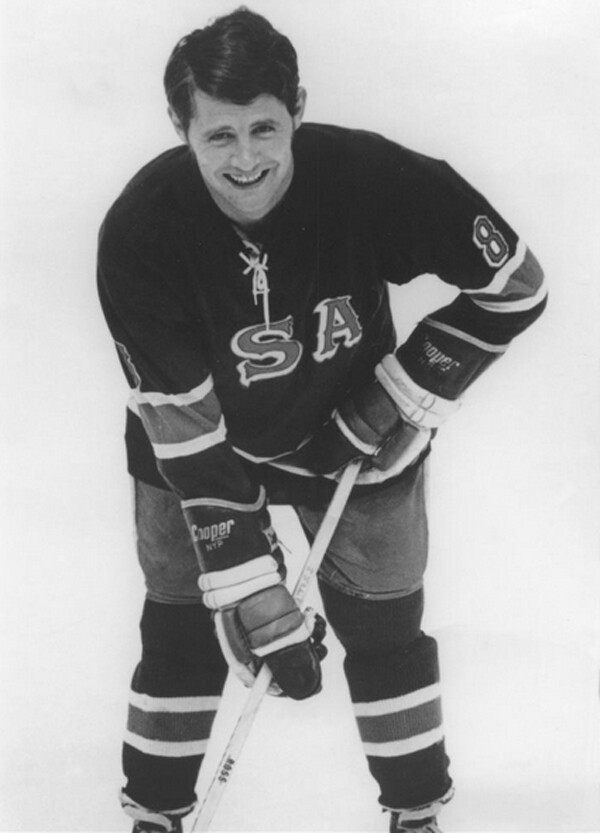
It won’t be the same, attending a UMD hockey game and never seeing Keith (Huffer) Christiansen there again. Those of us who watched UMD move from MIAC to Division 1 independent, and then into the hockey big time in the WCHA, know that it goes without saying the Huffer was the best and most exciting player to ever wear a UMD uniform.
It could be said that Huffer singlehandedly put UMD into the big-time of college hockey, but after he died earlier this week from lung cancer that evolved into pneumonia, I realized that there are a couple generations of UMD hockey fans who have no idea who or what Huffer Christiansen was.
His wife, Evie, and their son, Brad, and daughter, Marla Halvorson, were with Huffer a lot since he learned he had Stage 3 lung cancer in August of 2017, and they were with him at the St. Luke’s Hospital Intensive Care Unit, where he spent his final week, before complications ended his life at age 74.
Hockey fans all can share in the sadness, but they need to know about some of his accomplishments. He grew up in Fort Frances, Ontario, which is across the Rainy River from International Falls, and in those days, the Broncos crossed the bridge to play in Fort Frances, and all the kids in International Falls were born in the hospital, which was in Fort Frances. Christiansen found a way to get into International Falls High School, and in the 1961-62 season, he was the best player on the team and in the state as Falls won the state championship.
Somebody complained, and the State High School League ruled Christiansen ineligible for his senior year. Without him, Falls made it to the state tournament and lost an overtime final to St Paul Johnson - an overtime that wouldn’t have been required, had Huffer been on that team. The following three years, great International Falls teams won consecutive state championships - two of them undefeated.
Christiansen, meanwhile, came to UMD, which was plahing an independent schedule in the old Curling Club. Huffer, at 5-foot-6, was a stickhandling phenomenon who was never afraid to mx it up with much larger opponents. That must have made it even more frustrating when nobody could get the puck from him, and he would score. He was the leading scorer on the team as a freshman, and as a sophomore, and again as a junior, when UMD played its final game in the Curling Club as a first-year team in the WCHA. The Bulldogs finished eighth.
But the next season, when Huffer was a senior, was the prize. It was 1966-67, the year the Duluth Arena (later the DECC) opened, and while UMD finished sixth, Huffer Christiansen won the team scoring title with 23 goals, 39 assists for 62 points. UMD scored a season total of 124 goals that season, which means Huffer either scored or assisted on half of them.
But there ws more to that senior season: In WCHA games only, Huffer had 15-31-46, while his winger, Bruce McLeod, had 18-16--34 and finished second in league scoring. And Pat Francisco, his other winger, had 13-18--31 in league games to finish third. UMD finished sixth in the league, but the Christiansen-McLeod-Francisco line finished 1-2-3 in league scoring. The next year, McLeod dropped from 21 goals to 7. Something was missing. Huffer had graduated.
The opening game in the Duluth Arena was one for the ages. Minnesota came up to help dedicate the rink in a season-opening league game. Quite matter-of-factly, Huffer told his wingers to not worry about anything, just go to the net. Then he skated all around the rink, luring frustrated Gophers to chase him all over the ice before he fed his teammates. McLeod and Francisco each got two goals, and Christiansen registered six assists - which still stands as the UMD team record for assists, and points, in a game.
I had the pleasure of watching and writing about Huffer in his UMD games, and later, when, as a naturalized U.S. citizen, he was captain of the 1972 U.S. Olympic team, and then when he played for the Minnesota Fighting Saints, and former NHL stars such as Dave Keon, Ted Hampson, Wayne Connelly, and others all remarked about how they’d never seen anyone who could make perfect passes the way Huffer did.
“I have not seen, a better player, or played with a better player, than Huffer,” said Mike Sertich, who was a teammate of Christiansen at UMD. The two remained close friends forevermore, frequently going on fishing trips together to remote Canadian lakes. They loved to heckle each other, including the years when Sertich coached the Bulldogs to three WCHA titles and a couple of Frozen Fours. And Huffer’s quick wit will be recalled in Huffer stories forever.
When the pendulum swung the other way and UMD slumped, he was convinced to resign, although he dearly wanted to keep coaching. When Michigan Tech decided to make a midseason change of coaches, Tech hired Sertich. In his first week, still trying to learn his new players’ names, he prepared for the first game, which was at UMD. As fate would have it, Tech pulled off a major upset and beat the Bulldogs at the DECC.
“After the game, I came out of the visiting locker room,” recalled Sertich. “The first person I saw was Huffer. He came up to me and said, ‘You had us playing so bad, even you could beat ‘em.’ “
Always quick-witted, Christiansen was a devoted family man, and brightened the day of every customer he dealt with at Kolar Toyota. But he was a tenacious competitor who never lost his love for finding a pickup hockey game to play in. With the puck on his stickblade, he was capable of spectacular things, always.
The only foe he couldn’t find a way to beat was lung cancer. He will be missed by all who knew him, and nobody should ever have to think for the answer when somebody from out of town asks who UMD’s greatest hockey star was. That No 9 hanging in the rafters is a hint.
There will be a visitation followed by a service for Huffer Christiansen Saturday, starting at 12:30. It will be at the DECC, which is appropriate, because while changing the facility’s name from Duluth Arena to Duluth Entertainment Convention Center, they should have just called it “The House that Huffer Built.”

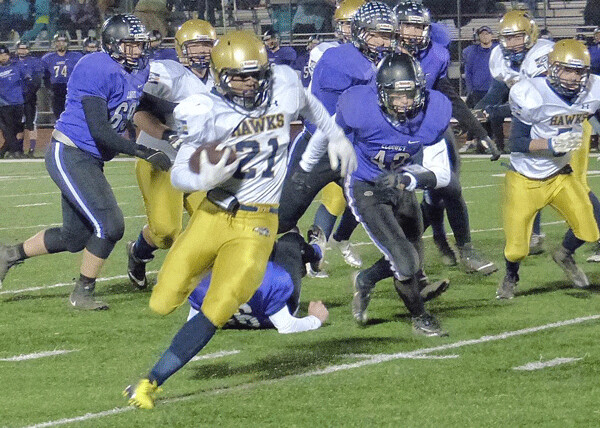
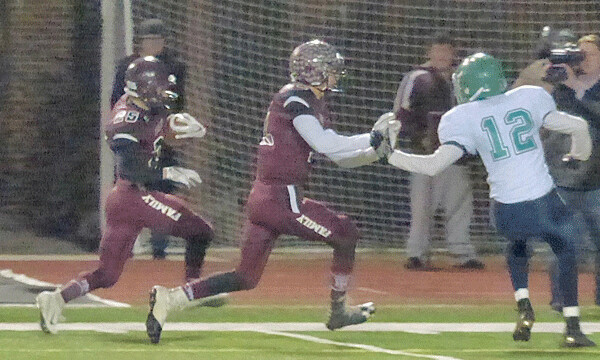
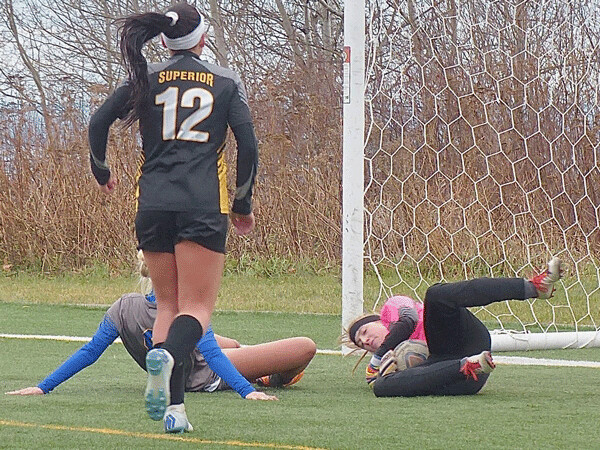
Football, Soccer Spectacles
It’s always fun to watch St. Scholastica play Wisconsin-Superior in any sport, so I fiured the UMAC women’s soccer playoff semifinal last weekend at St. Scholastica between the two had to be worth a little chilly weather. It was.
The teams fought to a scoreless tie, through the first half, and almost all the way through the second half, because even though the Saints dominate play and put constant pressure on UWS, freshman goalkeeper Madison Gutekunst kept diving across the goal making spectacular saves.
In the final minute, UWS got a corner kick from the right, and the ball was deflected in the congestion and bounced high. Saints goalie Roni Rudolph jumped for the ball, as did UWS forward Sarah Fjeran. Rudolph caught the ball, but as she came down, she bumped the ball off Fjeran and it fell to the ground. In the mass of players going for it was Erin Schoborg, and when the ball went into the goal with 37 seconds remaining, she was given credit for the goal. But actually she never touched it, explaining that the loose ball hit the ankle of a Saints defender and was knocked in.
The Yellowjackets were elated and celebrated at length. I asked second-year coach Allison DeGroot if they had been to the playoff finals before. “We’ve never even been to the playoffs before,” she said. “And we had never beaten St. Scholastica in soccer, ever.”
The Saints had baeten UWS 5-0 and 1-0 during the regular season, and won the UMAC with an 11-0-1 record, while UWS was 6-5-1 to qualify for its first playoff chance. In the championship game, Northwestern beat UWS, but those Yellowjackets will never forget that drizzly, frigid afternoon when they beat St. Scholastica.
Two Harbors goes to the state football tournament, meeting Perham Saturday at Brainerd after winning a 26-18 7AAA final over Greenway/Nashwauk-Keewatin. Before a spectacular clinching touchdown, the Agates led 20-18, and the differnece in the game was that Greenway/Nash-Kee didn’t have a place-kicker, while Two Harbors had borrowed one from the Agates boys soccer team, and all he did was kick two field goals and two decisive extra points.
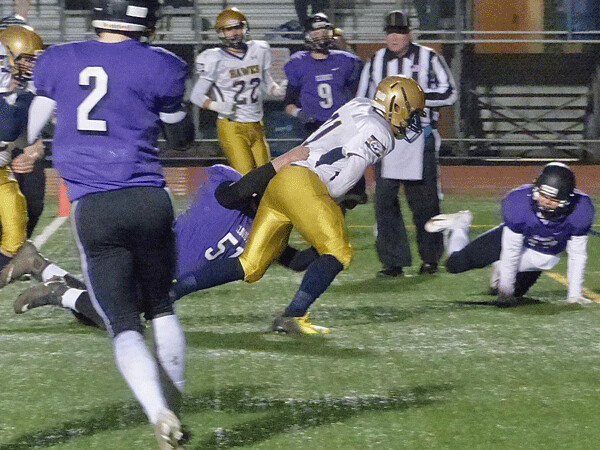
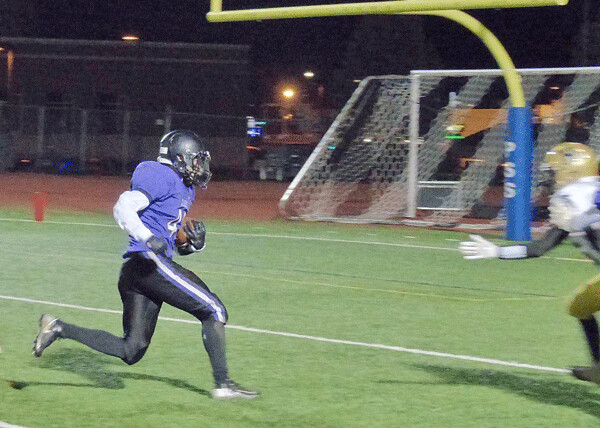
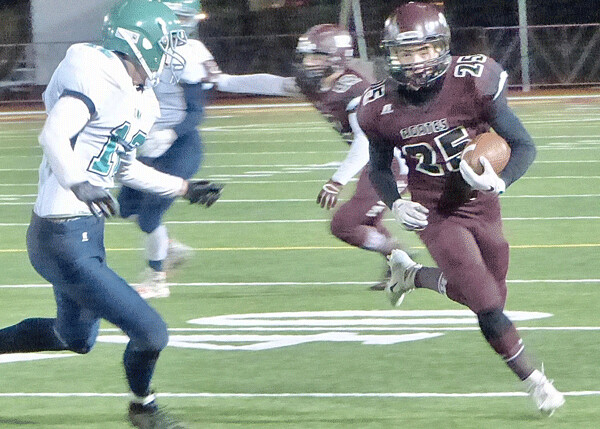
In Class AAAA, Hermantown avenged a loss to Cloquet by winning the rematch 20-14 in the 7AAAA final at Public Schools Stadium. David Cornelius, Hermantown’s workhorse running back, scored two touchdowns and ran through and around the Lumberjacks. But Cloquet didn’t have its star running back, Markus Pokernowski, who had run for 180 yards and two long touchdowns before injuring his shoulder in the semifinal victory over Denfeld.
Still, after Cornelius scored the opening touchdown, Cloquet took a 14-6 lead on touchdowns by Andre Peters and Ryan Badger, and seemed in command until Cornelius scored again just before halftime to cut it to 14-12. Tate HJansen threw a 22-yard touchdown pass to Noah Torgerson in the third quartrer to give the Hawks their first lead, and Cornelius plowed in for a 2-point conversion for the 20-14 final.
